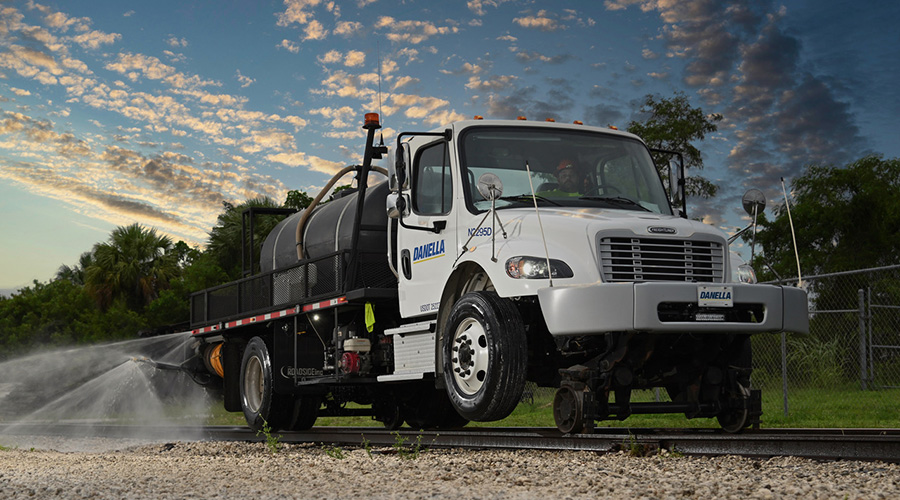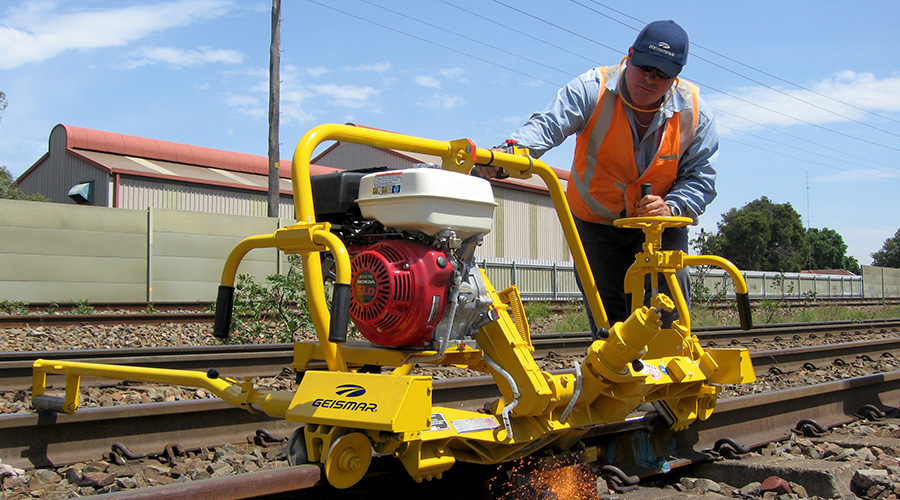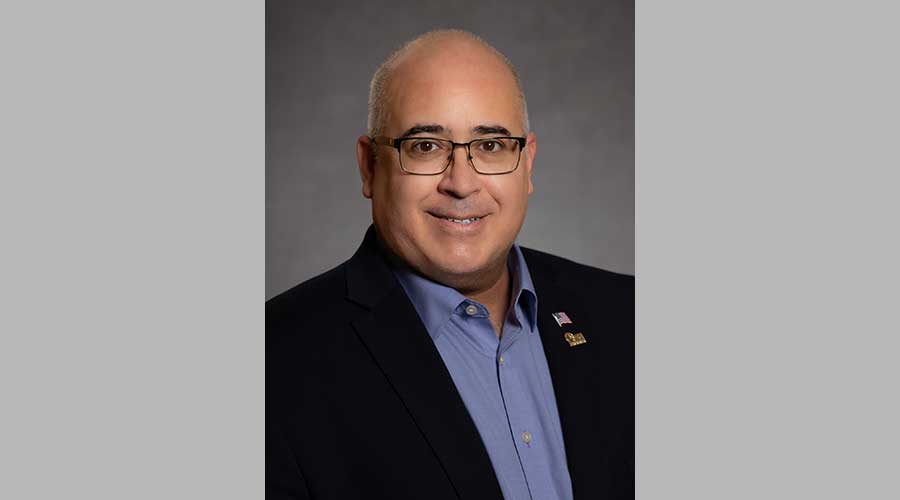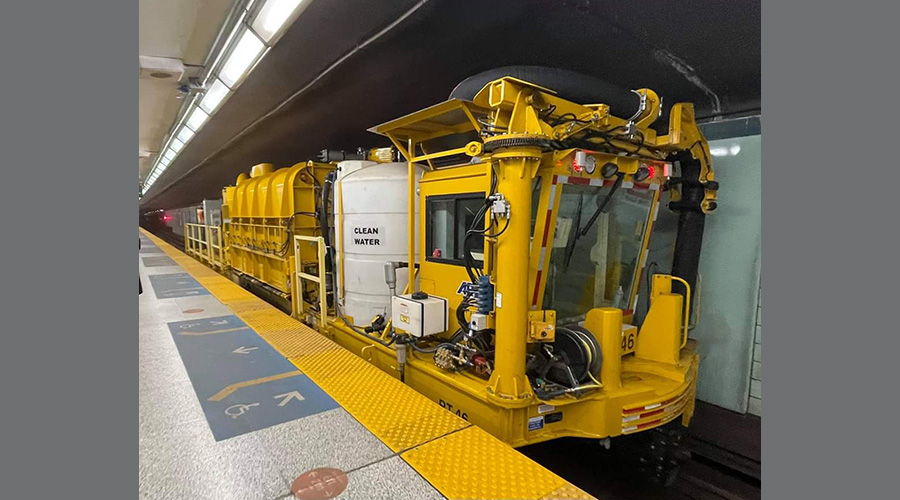Stay updated on news, articles and information for the rail industry
August 2007
Rail News: MOW
The bridge between something old, something new
Railroad bridges and trestles range from several feet spanning a small creek to hundreds of feet stretching across a wide river or deep canyon. Regardless of size, each structure is critical to keeping North American railroads moving.
Union Pacific Railroad and Amtrak can attest to the importance of a 1,400-foot wood trestle near Sacramento, Calif., over which an average of 50 freight and passenger trains cross daily. In March, the railroads had to reroute trains for nearly two weeks after a fire occurred on the bridge.
Whether damaged by a natural disaster, weakened by age or outclassed by today’s axle loads, bridges need to be repaired or replaced as quickly as possible. So, railroads and their engineering firms and contractors continue to employ different designs and construction techniques, standardize components and use special equipment to speed bridgework, minimize traffic disruptions and replace old structures.
They’re also trying to coordinate work quickly.
For example, UP marshaled workers and supplies, and hired contractors, including Foundation Constructors Inc., while the California bridge continued to burn on a Thursday and Friday in mid-March.
“Gary Perlichek, our vice president, was on site before the fire was fully out, so that by 6 a.m. on Saturday, we had employees and equipment on site,” says Foundation Constructors Project Manager Dermot Fallon.
Foundation Constructors employed 190 workers, who drove all piles and set all steel caps and stringers necessary to replace the bridge.
Eleven days after the fire was extinguished, the first revenue train crossed the new trestle. The fire had forced UP to close its mainline between Sacramento and Oakland, says Todd Martindale, the railroad’s director of construction.
To ensure a bridge over the Ouachita River in Monroe, La. — over which 25 Kansas City Southern trains cross daily — wouldn’t need to close because of a protracted replacement project, TranSystems Corp. devised a way to rebuild the structure.
“The swing-style bridge pivots on a center pier, which is shifting, and we developed a method to build a new support column to take the weight off the old pier and avoid replacing the structure,” says Jim Terry, TranSystems’ client manager for KCS.
To begin this summer and conclude in mid-fall, the project calls for building concrete piers on both sides of the old center column and positioning steel beams. Crews then will jack up the bridge, and install a reinforced concrete collar and replace a power mechanism that will rotate the structure.
Meanwhile, another TranSystems’ bridge design is gaining popularity: flyovers. The structures eliminate choke points where several railroads meet at grade, enabling roads to increase velocity on their mainlines and reduce the need to coordinate traffic in busy areas.
TranSystems designed the triple-decker Kansas City Junction or Argentine flyover in Kansas City, Mo., which opened in 2005 and separated BNSF Railway Co. and Union Pacific Railroad lines. The structure solved severe traffic congestion problems in the area, says TranSystems Executive Vice President Rick Morsches.
BNSF and UP have expressed interest in a “super grade separation” at the Tower 55 crossover in Fort Worth, Texas, as has UP for its busy lines in Nebraska, he says. UP averages about 160 coal and intermodal trains daily on the lines.
Conceptually speaking
Railroads also continue to show more interest in design/build projects, which more frequently are employed for highway work, according to bridge design and construction firm E80 Plus Constructors L.L.C. A design/build concept provides a single contractor the flexibility to use best practices and schedule materials and work while designing and constructing a project.
“We can proceed through the entire project using the design/build concept, benefiting both the railroad and our company,” says E80 Plus Operations Manager Brian Haight, adding that the concept helps ensure the parties use the most cost-effective techniques and minimize work windows.
In addition, railroads are outsourcing more bridgework because they don’t have the necessary personnel, he says.
“We are now doing more turnkey projects,” says Haight.
Stacking the deck
Another ongoing trend: the installation of ballast-deck bridges. Engineering firm HDR Inc. is incorporating ballast-deck designs into many of the 100 projects the firm currently is handling for Class Is and short lines.
“We’re seeing more ballast-deck vs. open-deck bridges as they have a longer life span and make track maintenance around these bridges easier,” says Bob Yechout, HDR’s senior VP and national technical director-rail group.
HDR engineers also analyze access to a work site and other factors to determine the optimal structure type — long vs. short span — and best construction methods.
In addition, many designs incorporate precast concrete instead of steel stringers on steel caps to eliminate welding and speed assembly, and standardized bridge components.
“One of the trends we see is the standardization of bridge elements, which speeds up component delivery since these elements can be stock items,” says Jeff Teig, HDR’s rail bridge section manager.
Adds Yechout: “We can reduce the amount of track downtime and reduce the amount of field assembly with these standardized components.”
Fully equipped
Osmose Railroad Services Inc. also is employing different techniques and equipment to minimize track downtime during bridge projects.
“We have some proprietary and unique tools and equipment, which allow us to make repairs, such as changing caps on ballast-deck bridges, with little disruption to traffic,” says Osmose Regional Manager David Ostby. “We also look for access to the work site that does not require assistance from the railroad, as this helps our production time and minimizes [traffic] delays.”
The South Florida Regional Transportation Authority (SFRTA) used different techniques and equipment, too, to build a second bridge over the New River in Fort Lauderdale between July 2003 and April 2007.
Used by SFRTA, Amtrak and CSX Transportation trains, the old single-track, bascule-style bridge built in 1926 would have been a choke point after the authority opened a double-track segment and implemented a new daily 50-train schedule in early July, says Dan Mazza, SFRTA’s director of engineering and construction.
In truss we trust
To complete the project, crews from design/build contractor Washington Group International used a 290-foot-long Italian-made launching truss to install pre-stress concrete girders. The truss lifted the girders from a truck and moved forward section by section as installation was completed.
SFRTA needed the truss to build a 30-foot-wide bridge in a corridor with an average width of 42 feet, says Mazza.
“We had to fit the bridge along I-95, between two highway overpasses that could not be changed, and keep the grade to a manageable degree while having the bridge high enough to allow marine traffic to pass underneath,” he says, adding that traffic from a busy marina to the east of the bridge has the right of way.
The authority built the bridge with a clear span height of 55 feet to meet marine traffic needs and a 3 percent grade to accommodate SFRTA and Amtrak trains. CSX will continue to use the old bridge.
Norfolk Southern Corp. also is targeting old structures as part of this year’s bridge program. The Class I has budgeted $36 million to replace 135 wood trestles and repair 19 bridges.
Crews are replacing timber trestles with pre-stressed concrete, and replacing wood piles with steel pipe filled with concrete.
“The timber trestles have come to the end of their economically sustainable life,” says NS Chief Engineer of Bridges and Structures Jim Carter. “Timber trestles generally require more maintenance than either steel or concrete bridges, and are susceptible to fire, decay and attack by insects.”
NS tries to use as many prefabricated materials as possible during projects to speed work and minimize traffic disruptions.
Keeping options open
To further reduce track downtime, the railroad is considering whether to have crews drive piles in clusters and work on either side of a bridge, says Carter.
“Working outside the clearance envelope as much as possible could speed up work in locations where track time is very scarce,” he says. “If track time was hypothetically not an issue, then more conventional construction makes sense, because it is then more economical. There is a point where the economics swing the other way, and we are still looking at that.”
One thing that isn’t a major factor in NS’ bridgework strategy is axle-load limits. All bridges across the railroad’s core system are rated to handle 315,000-pound cars, says Carter.
However, many short lines and regionals still are trying to upgrade bridges to 286k axle-load standards.
A Zeta Tech Associates Inc. study conducted in 1998 showed short lines needed to spend between $2 billion and $3 billion to upgrade their bridges, but that figure in 2007 dollars is closer to $5 billion, says American Short Line and Regional Railroad Association (ASLRRA) Vice President and Executive Director Steve Sullivan.
So, the association plans to institute a 10-point bridge program that calls for forming a task force with the Federal Railroad Administration (FRA) and other constituents to collaborate on bridge maintenance and safety, and providing best practices to ASLRRA members.
“Our task force will be made up of chief bridge engineers from the Class Is, CEOs from short lines and regional railroads who have successful bridge programs, and engineering officers from different groups, such as HNTB Corp., Osmose Railroad Services and HDR,” says Tom Streicher, ASLRRA’s general superintendent of safety and security practices.
Points to ponder
The 10-point program also includes a plan to inventory and assess 17,000 short-line bridges within three years, and near-term goal to forge relationships with the Class Is, FRA and American Railway Engineering and Maintenance-of-Way Association to share developments in bridge research, standards and maintenance.
In addition, the ASLRRA plans to provide safety bulletin articles and tips on bridge safety and inspection; conduct breakout sessions on bridge inspection and maintenance at its annual and regional meetings; create a bridge recognition program; and provide members a CD-ROM to help short-line officials self-assess their bridges and calculate ratings for each structure.
“We will be working with the National Academy of Railroad Sciences to develop an Internet unit of instruction related to inspections and maintenance of short-line bridges, as well,” says Streicher.
Since old bridges present load-bearing problems, designs need to be set to a minimum of 286k standards, says HDR’s Yechout.
“Older bridges were not designed for current or future axle loadings, shortening the bridge’s lifespan,” he says.
Although railroads are trying to address old structures and apply best practices, there’s a fly in the ointment that could slow their attempts to upgrade bridges.
“We’re seeing a shortage of steel,” says TranSystems’ Morsches. “That could extend lead times by six to nine months, and present a challenge for developing lead times.” 
— Walter Weart is a Denver-based free-lance writer.
Keywords
Browse articles on railroad bridge rail bridge wood trestle Union Pacific Amtrak Foundation Constructors TranSystems Kansas City Southern E80 Plus HDR Osmose Railroad Washington Group Zeta Tech FRA Federal Railroad Administration HNTB National Academy of Rail SciencesContact Progressive Railroading editorial staff.


 LRW Honors Amtrak’s Acheson As Railway Woman Of The Year
LRW Honors Amtrak’s Acheson As Railway Woman Of The Year
 From Editor-In-Chief Foran: Of Gender Equity And Inclusion
From Editor-In-Chief Foran: Of Gender Equity And Inclusion
 Spotlight On Some Of Today’s Rail Safety Products
Spotlight On Some Of Today’s Rail Safety Products
 Women of Influence in Rail eBook
Women of Influence in Rail eBook
 railPrime
railPrime







